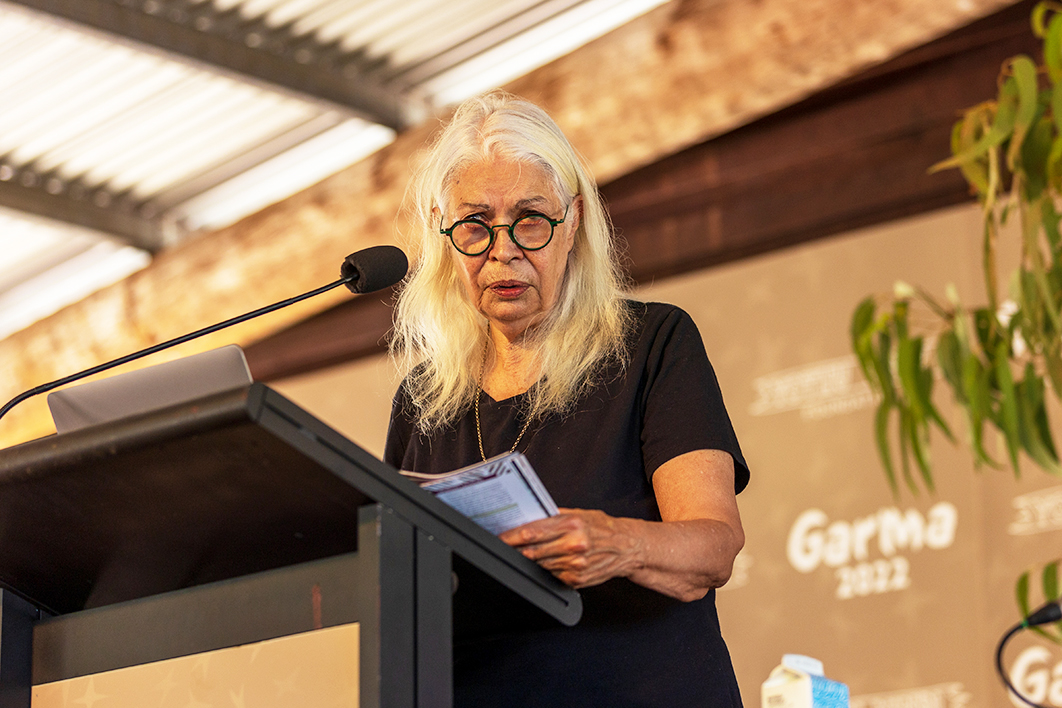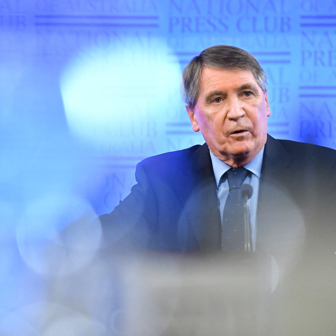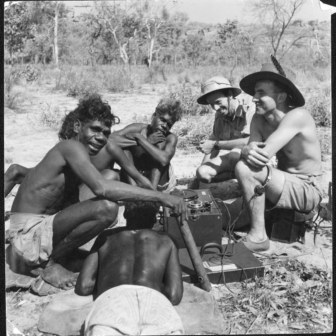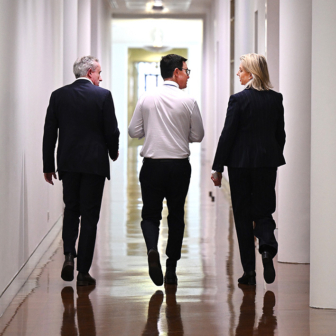Should the Indigenous Voice to Parliament be created legislatively — according to the model proposed by Tom Calma, Marcia Langton and their colleagues on the government-appointed co-design committee — and only then put to a referendum? Or should the Voice come after treaty-making and truth-telling, as the Australian Greens propose? Or should we forget altogether about creating an Indigenous Voice, as Country Liberal Senator Jacinta Nampijinpa Price seems to recommend?
Since the election, Anthony Albanese and his government have pushed ahead with yet another option — a referendum first, without too much detail about how the Voice would be formed and operate, with legislation to follow. At the Garma Festival on 31 July the prime minister provided the words he would like voters in that referendum to add to the Australian Constitution.
There shall be a body, to be called the Aboriginal and Torres Strait Islander Voice.
The Aboriginal and Torres Strait Islander Voice may make representations to Parliament and the Executive Government on matters relating to Aboriginal and Torres Strait Islander peoples.
The Parliament shall, subject to this Constitution, have power to make laws with respect to the composition, functions, powers and procedures of the Aboriginal and Torres Strait Islander Voice.
That approach seems popular. Sixty-four per cent of the 3168 Australians surveyed by the Resolve Political Monitor in August and September said “yes” when asked, “Do you support an alteration to the Constitution that establishes an Aboriginal and Torres Strait Islander Voice?”
The government, Albanese added, is open to further consultation on the exact words to be added to the Constitution. Over the next few months, a series of expert workshops will consider Albanese’s words and perhaps suggest changes. How the Constitution should refer to the Voice’s scope is likely to be one theme of discussion: arguably, all matters dealt with by Australian governments are “relating to Aboriginal and Torres Strait Islander peoples” but some people will want to circumscribe the Voice’s attention.
At the same time, the government is seeking counsel on how to run the referendum itself. In August, it appointed a working group of First Nations leaders, including Indigenous Australians minister Linda Burney and senator Pat Dodson, to advise on three matters: the timing of a referendum, the words of the proposed referendum question and the information about the Voice to be issued to the public before the vote.
To decide what to say about the Voice itself before the referendum is the most difficult issue facing the government. The Albanese government has said very little so far because it would like to distinguish two political tasks: the task of persuading voters to put an Indigenous Voice in the Constitution, and the task of persuading parliament to legislate the Voice in a certain form. But the distinction between the two has come under pressure: the government won’t be able to campaign for a Yes vote in the referendum without giving an outline sketch of the Voice. It will need to say something, soon, about the bill it would introduce after the referendum to legislate the Voice.
The government is correct in saying that parliament will have the final say in the Voice’s design, but parliament can’t deliberate without a bill to consider. Many want to know what would be in that bill. The prime minister’s plea at Garma that we endorse a change to the Constitution as an act of good manners has fallen flat.
Morrison’s road not taken
Before it was thrown out of office in May, the Morrison government had made two significant steps towards creating the Indigenous Voice. The first, in December 2021, was to release the final report of the Indigenous Voice co-design process chaired by Calma and Langton. The second was to allocate $31.8 million in this year’s budget “to progress the establishment of Local and Regional Voices,” in the words of the Coalition’s Indigenous Australians minister, Ken Wyatt. (Langton and Calma’s report received very little public attention, but I have provided an overview at Australian Policy and History.)
Langton welcomed the Morrison government’s financial commitment. Against those who want a referendum on the Voice as soon as possible, before the legislation is developed, she and Calma have argued for building the Voice first. Work would start on constructing the thirty-five Local and Regional Voices, which would then, after an estimated two years, choose the members of a National Voice to Parliament.
Only then, in this scenario, would a referendum be held — though Calma and Langton could not say this in their final report because Wyatt’s terms of reference forbade any mention of constitutional recognition. If the voting public saw the existing Voice as an effective and legitimate body, a future government committed to constitutional recognition would find it easier to persuade voters to put the Voice into Australia’s Constitution.
This legislate-first scenario had three political weaknesses. One was that Scott Morrison had followed his predecessor Malcolm Turnbull in saying that he would not submit the Voice to a referendum. Morrison was prepared to start building a Voice, but constitutional recognition of Indigenous Australians, he said, should take some other form. The second was pointed out by those agitating for constitutional entrenchment to precede legislation. A Voice that was merely legislated would lack the moral and political legitimacy that a referendum would provide, making it less effective, less attractive to potential Indigenous leaders and always vulnerable to legislative dissolution — the fate inflicted in 2004–05 on the Aboriginal and Torres Strait Islander Commission, or ATSIC, by a Coalition government with Labor’s support.
A third weakness was that a government and the voting public might say of the functioning Voice: is there any need to provide for it in the Constitution if it is already working well as a legislated body?
The election as mandate
Backing the referendum-first approach was one way for Labor to differentiate itself from the Coalition. But between the announcement of the election and polling day the major parties said little about the Voice or constitutional recognition. For voters concerned with Indigenous affairs the election did present a choice, however: Labor promised and the Coalition refused a referendum on the Voice. But both parties treated this difference as if it did not matter to voters.
The Voice advocates who assembled in April to make the Yarrabah Affirmation sought to make it matter. They framed Labor’s commitment to a referendum as voters’ opportunity to help stage national renewal. “History is calling,” they said.
Did the effort to promote a Voice referendum as a nation-defining opportunity make a difference to anyone’s vote in May? We can’t say, but it certainly gave Anthony Albanese the theme for his victory speech on election night. He chose to highlight Labor’s promise to hold a referendum in the next term of parliament, as if that had been what the election was all about. Labor’s triumph, he implied, was his mandate to conduct a referendum.
The change of government thus switched Australia onto a different pathway to the Voice. Instead of slowly constructing a legislated Voice, building from the local and regional upwards — without assurance that the Voice would ever be put to referendum — Australia will debate, between now and the end of 2024, whether to entrench the Voice in the Constitution. If the referendum is successful, the government will be obliged to legislate the Voice. If the voters reject the referendum, a government could still decide to legislate a Voice.
An almost-neglected model of the Voice
Having committed to holding a referendum first, the Labor government must now decide what to do with the model the Morrison government had budgeted for.
In the first week of August, after Garma, the prime minister acknowledged the existence of the Calma–Langton report and its relevance to Labor’s post-referendum drafting of a bill. But he would say nothing about what Labor likes and dislikes about the Calma–Langton model. Linda Burney was less circumspect. Evidently, she doesn’t agree with one of the report’s central recommendations: that the members of the National Voice be chosen by the Local and Regional Voices, meeting within their state or territory, rather than directly elected by Aboriginal and Torres Strait Islander voters.
A few days after being sworn in as minister Burney was reported as saying that the Voice “needs to be elected, that it should have gender parity and that young people and the voices of Torres Strait Islanders must be represented within the body.” Burney didn’t acknowledge that she was here contesting a major Voice design issue.
The history of ATSIC suggests that only a small proportion of Indigenous Australians would vote in a non-compulsory poll. Rather than allowing all Indigenous Australian voters to elect National Voice members, Calma and Langton’s “structurally linked” membership model would, they suggest, secure the legitimacy of the National Voice better than the direct election of its members by a small proportion of Indigenous voters.
Little commentary on the Calma–Langton model has been published since Burney’s remark. Megan Davis, writing in the Australian in July, made two criticisms of what she calls “the Wyatt model.” She reminded readers that Wyatt had not allowed Calma and Langton to say whether the Voice should be entrenched in the Constitution. I understand Davis as saying that now Labor is committed to a referendum on the Voice any model that was conceived under Wyatt’s brief is less relevant.
Davis also said that the Wyatt model was “a voice to government, not a voice to parliament.” Actually, Calma and Langton proposed that it be both. Putting that aside, why should the Voice not be “to government”? Davis didn’t say.
Any discussion of how Indigenous Australians might use a Voice to speak “to government” will need to include Pat Turner, chair of the Coalition of Peaks, an alliance of Indigenous organisations that believes it has created a way of talking to government agencies delivering Closing the Gap programs. As far back as November 2019, Turner was quoted as fearing that a “messy, incoherent ecosystem of Indigenous representative mechanisms” was forming. Perhaps that is also Davis’s concern?
Wyatt invited Turner to sit on Calma and Langton’s advisory group, and it is likely that she contributed to their recommendation that the Local and Regional Voices be formed in a way that respects and complements the processes of Indigenous representation already established in each region. Such existing Indigenous organisations are the base of Turner’s Coalition of Peaks.
After the election of Labor in May 2022, Turner renewed her vigilance about Voice design. In June and July she was reported to be urging the government to issue more “detail on how a national Voice would work.” Marcia Langton felt obliged to assure Turner that “nothing in our [final report] will affect the Coalition of Peaks or efforts to close the gap.” Langton was also reported to be critical of Turner for saying that she couldn’t support the Voice until she sees some “meat on the bones.”
Though some Voice advocates have been irritated by Turner’s calls for detail, she has reportedly said that she is seeking merely to counter “unhelpful speculation” about the Voice. Here we see a puzzle facing those campaigning for Yes. Whose demands for more detail are merely mischievous (bad faith campaigning for a No vote, in other words) and whose demands arise from their legitimate interest in what the Voice could be?
Turner was also concerned that focus on the Voice was drawing the public’s mind away from the Closing the Gap agenda. “The Voice is easier to talk about than Closing the Gap. We need to do both,” she is reported to have said.
Thorpe and Price as outliers
Flanking this patchily reported Indigenous discussion of the Calma–Langton model are the dissenting commentaries of two senators, Lidia Thorpe, a Victorian Green, and Jacinta Price, an NT Country Liberal member. Neither seems interested in questions of Voice design.
Since choosing Thorpe to replace Richard Di Natale in June 2020, the Greens have opposed the creation of the Voice before the Australian government negotiates a treaty based on truth-telling. The May 2022 election gave Thorpe a further six years, and the Greens have made her their deputy leader in the Senate. Her strength within the party raises the question: would the Greens vote against a Labor referendum bill?
After the election, Yes campaigner Thomas Mayor thanked Greens leader Adam Bandt for saying that the Greens would not try to stop a referendum being held. Mayor also pointed to survey evidence that “more than 70 per cent of Greens voters support a Voice referendum.” But Thorpe also speaks for the Greens, and in June, according to the Australian’s Troy Bramston, she said that Australians aren’t ready to vote on the Voice and it would be risky to proceed before a treaty was negotiated between the Commonwealth and Indigenous Australians.
Looking for common ground, Burney and the Greens have conceded that the Voice, the treaty and truth-telling could be pursued simultaneously. As a quid pro quo, Thorpe has asked the government to commit to implementing all the recommendations of the Royal Commission into Aboriginal Deaths in Custody (1991) and of the Bringing Them Home report (1997), and to legislating the UN Declaration of the Rights of Indigenous Peoples (2007) as Australia’s standard of Indigenous self-determination.
Labor would not have to find common ground with the Greens if the Liberal and National parties agreed to support a referendum bill and joined Labor to argue for Yes. A Yes campaign led by an Albanese–Dutton unity ticket would have a very good chance not only of winning but also of marginalising the Greens’ (or at least Thorpe’s) approach to Indigenous affairs.
When Dutton appointed Liberal moderate Julian Leeser as shadow Indigenous Australians minister he signalled that he is keeping the door to bipartisanship open. But Price pledged on 27 July, in her first speech to the Senate, to resist the opposition’s move to the political centre.
“This government has yet to demonstrate how this proposed Voice will deliver practical outcomes and unite, rather than drive a wedge further between, Indigenous and non-Indigenous Australia,” she said. Not all Indigenous Australians wanted the Voice, she went on, arguing that a Voice would, in effect, “disregard” Indigenous MPs such as herself. Narratives about Australia’s racism, she added, were being mobilised to promote a Voice that was itself predicated on racial division.
Hailing Price’s speech, some of the more right-wing Murdoch journalists regretted that Dutton had appointed the conciliatory Leeser.
More detail on the Voice?
If we take Thorpe and Price at their word, they are unlikely to be won over by more detail from the government about the Voice’s likely form, functions and powers. Neither of them has commented, as far as I know, on the Calma–Langton plan – for better or worse, the only published model of the Voice. For these two senators to grapple with issues of institutional design, they would need to climb down from the rhetorical plinth where each has become an icon of her constituency. We may yet see such engagement, but don’t hold your breath.
Political progress on the referendum is within Albanese’s reach if he discusses with the opposition the possible institutional meanings of the words “make representations to Parliament and the Executive Government on matters relating to Aboriginal and Torres Strait Islander peoples.” Perhaps that discussion is already taking place in private. Some have suggested a parliamentary inquiry as a forum for such an exchange. It could lead to a set of principles — agreed between government and opposition — to guide the drafting of a post-referendum bill.
That possibility was touted by Malcolm Turnbull when he announced in the Guardian on 15 August that he would vote Yes. Turnbull spent much of his article respectfully summarising the Calma–Langton model, with the disclaimer that it is unlikely to be “the definitive last word.” Acknowledging that parliament, not Albanese and his colleagues, would design the Voice, he asked the government for “some clear design parameters.”
Such a move would give rise to more public discussion — before the referendum — of the form, functions and powers of the Voice. But is the government willing to stimulate such discussion? Since Burney presented her view that the Voice should be elected, she and the rest of the Albanese government have gone quiet.
They have justified their reticence by referring to the defeat of the 1999 republic referendum. On that occasion, proponents of a republic were divided on the question of whether a head of state should be chosen by popular vote or a decision of parliament. When the 1999 referendum question offered parliament as the body to appoint a head of state, some republicans who favoured direct election sided with monarchists rather than campaign for a “politicians’ republic.”
Burney fears alienating some supporters of the Voice by being too specific about its form, functions and powers. “I don’t know having a detailed model [of the Voice] out there would lead to a clean question about what should be observed in the Constitution,” she has been reported as saying. At the Garma Festival Albanese said that “one of the things I am trying to avoid” is “people looking for all of the detail and saying well… if you disagree with one of the fifty but forty-nine are OK, vote no. We’re not doing that. We’re not doing that. We’re learning from history.”
A No campaign would have a range of messages — not only the argument of principle to which some Liberals hold (that an Aboriginal and Torres Strait Islander Voice privileges some Australians on the basis of their “race”) but also the cautionary argument that the Voice is an incalculable and unnecessary risk.
By showing that the Yes vote for the Voice is “soft,” Resolve’s poll pointed to an opening for the cautionary argument. It found that 64 per cent preferred “yes” to “no” when they were the only two answers allowed, but just 53 per cent said “yes” when “undecided” was an option, because one in five (19 per cent) respondents said that they were “undecided.”
A No campaign that targets those undecideds could refer to the Voice as a hazardous unknown. The risk in saying nothing about the model of the Voice is that voters who don’t feel sufficiently well-informed will be susceptible to that argument. •




